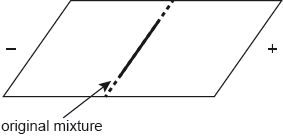| Date | May 2019 | Marks available | 1 | Reference code | 19M.3.sl.TZ2.6 |
| Level | SL | Paper | 3 | Time zone | TZ2 |
| Command term | State | Question number | 6 | Adapted from | N/A |
Question
Proteins have structural or enzyme functions.
Oil spills are a major environmental problem.
Some proteins form an α-helix. State the name of another secondary protein structure.
Compare and contrast the bonding responsible for the two secondary structures.
One similarity:
One difference:
Explain why an increase in temperature reduces the rate of an enzyme-catalyzed reaction.
Suggest two reasons why oil decomposes faster at the surface of the ocean than at greater depth.
Oil spills can be treated with an enzyme mixture to speed up decomposition.
Outline one factor to be considered when assessing the greenness of an enzyme mixture.
Markscheme
β/beta pleated/sheet [✔]
One similarity:
hydrogen bonding
OR
attractions between C=O and N–H [✔]
One difference:
α-helix has hydrogen bonds between amino acid residues that are closer than β-pleated sheet
OR
H-bonds in α-helix parallel to helix axis AND perpendicular to sheet in β-pleated sheet
OR
α-helix has one strand AND β-pleated sheet has two «or more» strands
OR
α-helix is more elastic «since H-bonds can be broken easily» AND β-pleated sheet is less elastic «since H-bonds are difficult to break» [✔]
Note: Accept a diagram which shows hydrogen bonding between O of C=O and H of NH groups for M1.
Accept “between carbonyl/amido/amide/carboxamide” but not “between amino/amine” for M1.
enzyme denatured/loss of 3-D structure/conformational change
OR
«interactions responsible for» tertiary/quaternary structures altered [✔]
shape of active site changes
OR
fewer substrate molecules fit into active sites [✔]
Any two of:
surface water is warmer «so faster reaction rate»/more light/energy from the sun [✔]
more oxygen «for aerobic bacteria/oxidation of oil» [✔]
greater surface area [✔]
Any one of:
non-hazardous/toxic to the environment/living organisms [✔]
energy requirements «during production» [✔]
quantity/type of waste produced «during production»
OR
atom economy [✔]
safety of process [✔]
Note: Accept “use of solvents/toxic materials «during production»”.
Do not accept “more steps involved”.
Examiners report
This question was quite well answered with many scoring the mark although there were quite a few incorrect responses that answered “beta-helix” rather than “beta-pleated sheet”.
The similarity in bonding between the 2 types of secondary structures was answered well but the difference was not. Most students were not descriptive enough to receive the second mark or simply repeated the idea of proteins containing an alpha-helix and beta-pleated sheets rather than describing something different about them.
This was another question where most candidates received one mark for identifying that the enzyme will denature with an increase in temperature. However, many candidates did not continue with the explanation of the active site shape changing or substrate molecules not longer fitting into the active site.
While many candidates did receive two marks for this question some candidates only suggested one reason or repeated the same reason (for example - heat and energy from the sun) even though the question clearly asked for two reasons.
Students tend to struggle with these questions and end up giving journalistic or vague answers that cannot be awarded marks. It is important for teachers to instruct students to give more specific answers directly related to the topics presented.


